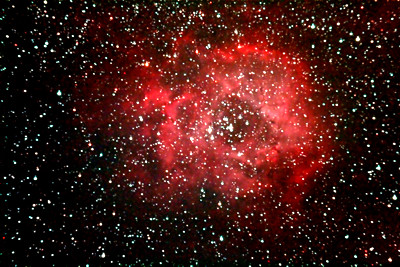Mike Jefferson reports that the GOES Satellite System recorded a nice C-Class Solar Flare on April 24th – perhaps the Sun is waking up; if we don’t get an aurora, perhaps there’ll at least be a sunspot to look at.
Mike Jefferson reports that the GOES Satellite System recorded a nice C-Class Solar Flare on April 24th – perhaps the Sun is waking up; if we don’t get an aurora, perhaps there’ll at least be a sunspot to look at.
Had a great time observing with Kerry. Arrived about 8:30 and got setup and after some problems with alignment we got to some deep sky observing.looking at several galaxies, globular clusters, and double stars. I had a early morning Mon. so packed up about 11:00 or so
Kerry’s update: Although we were expecting more obervers we still had a great time. I also had a nice opportunity to compare views of many DSO’s between my 6in and Jim’s 8in SCT.
Near the end of the night I decided to try out some imaging with my new setup the 80mm and c6 mounted side by side. I imaged through the c6 and had the 9mm illuminated reticle on the 80mm. There I was manual guiding for the first time ever (Tim Harpur makes it look so easy) Anyway after Jim left I managed to get a hang of the guiding and only had enough energy to get a few shots of M51 ~4 minute exposure each… see the results below. A little noisey and could have benefited from more frames but it is a first and there is always room for improvement 🙂 Tips or suggestions are very welcome…
M51: first successful DSO shot
By:KerryLH
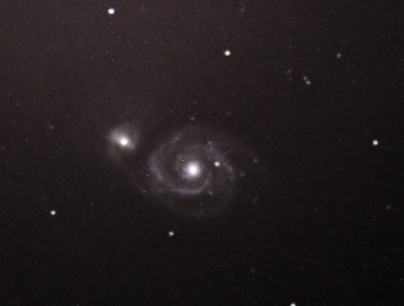
Night Photos (by Tim Harpur)
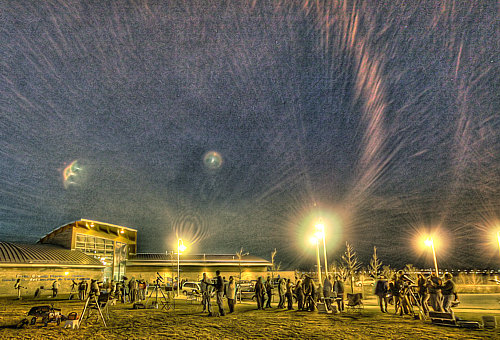
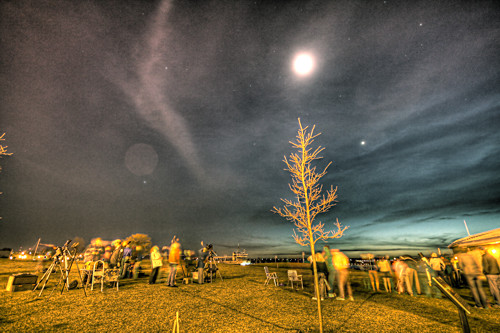
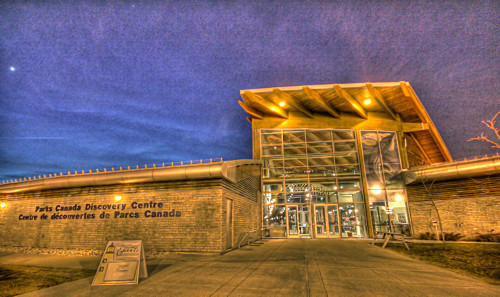
The Lyrid meteor shower is due to reach its peak around 4:00am Sunday. The CSC is predicting very favourable viewing conditions.
I didn’t have a lot of time to observe, last night, but the beautiful crescent Moon / Venus combination drew me under the clear skies above my backyard observatory.
The air was calm and the humidity about 55%, enough to soften the edges of Saturn and its rings, and give a bright beam to my laser pointer (my new test for transparency 😉
Still, Leo and Ursa Major were well-placed for a little galaxy hunting so I got busy and managed to bag the following 10:
M65, M66 (couldn’t pull in the NGC companion), M105, NGC 2903, M81, M82, M101 (you really have to know what you’re looking for to get that one), NGC 5194 & NGC 5195 (M51), and M94 which has a surprisingly bright core – almost looks like a tiny globular.
Overall, not bad for an hour’s observing 🙂
WOW! After a long unsettled first half of April it looks like the current forecast models are suggesting pretty nice weather just in time for Astronomy Day.
Since it is quite a few days away conditions may change but for the past two days the trend has been consistent with showing a ridge of high pressure that will build across much of the province. Associated with this will be fair skies and warmer temperatures for Saturday. There is a chance that we could be brushed with a few clouds from the tail end of a warm front but it doesn’t look detrimental at this time.
Anyway, I’ll post an update in a couple of days if things change.
KerryLH
Clear Skies to all!
A new image of the side-by-side open clusters M46 and M47 has been posted in my HAA Gallery.
Click here to see a new digital image with the Crab Nebula (M1) in it, taken by Bob Christmas on Tuesday, March 20, 2007 from Mountsberg, ON.
Not having the energy for a trip to the Planetarium, Gail and I invited Kerry over to check out our observatory. Kerry is just a short drive from us and arrived at dusk.
Since we haven?t had many observing opportunities, lately, I?d pulled out all the toys and, while we waited for stars to emerge, we started the evening with a look at the 5 day Moon with the binocular box . At an altitude of ~60°, the Moon was well up in the sky and Kerry was impressed with how comfortable the mirror design of the binocular box was to use on objects approaching the zenith.
While Venus was favourably positioned I put a green filter on a Pentax 21mm ep and after looking at the planet ?boil? in the atmosphere for a minute, we pushed our 6? reflector up to the Moon. Seeing was quite steady and the green filter was a nice change to the mundane gray of a regular ?Moon filter?. We upped the power, and spent a moment examining a low dark ridge bordering the terminator on the edge of Mare Nectaris.
The stars were out by then so I removed the filter and let Kerry practice aiming the dob using the bulls-eye sight of the Rigel Quikfinder. In Quikfinder succession we looked at Mintaka and Alnitak in Orion?s Belt, and multiple system Sigma Orionis just below it.
After the obligatory stop at M42 we went in search of some clusters.
The Pleiades were an obvious choice and provided a chance to compare views between our 6? f8 scope and the Starblast which is a 4.5? f4. The smaller, faster ratio scope enabled us to get the entire star field in view, and I showed Kerry how to see the warhorse asterism in M45. We then compared views of M44, the Beehive Cluster, and decided that small scopes with wide field of views are ideal for these kind of targets.
While hunting open clusters, we bagged M35 and its small companion NGC 2158, M67, and the popular NGC 457 or ET cluster. By then, Saturn had cleared the walnut tree and we had nice views of its attractions including 3 of the larger moons.
Disregarding the moonglow, we decided to hunt some galaxies and managed to pull in NGC 2903, M81 & 82, M108, and planetary nebula M97. Not bad!
We finished the night as we had begun, with the binocular box. A last, low-power, look at the Beehive Cluster then a final challenge of picking up M81 & 82. With the aid of my laser pointer Kerry brought them into view and added the laser pen to her must have list.
It was the best kind of informal astronomy night of which, I?m sure, there?ll be many more.
KerryAnn invited a few members of the HAA over to observe from her driveway – unfortunately for most they had prior obligations to attend an HAA council meeting and missed out on the opportunity 🙁
Although KerryAnn’s place is very close to the bright Grimsby city lights – it’s high up on the escarpment and well above the majority of the light pollution – it’s not Binbrook, but it is a very nice alternative site. The viewing wasn’t the best last night – with high humidity/haze and the occasional cloud floating over – but even so, we were able to make out some very faint objects – and Saturn presented excellent views in both Kerry’s 6″ SCT and my 80mm APO. When I setup my equipment I could see my breath and gave KerryAnn’s 6″ corrector about 45 minutes before dew would hit (she doesn’t have a dew shield yet) – I was wrong – it wasn’t until near the end of a 3 hour observing session that dew struck.
I had originally planned on imaging the Pleiades, but with the moon only a few degrees away I decided to go for the Rosetta (or Rosette) Nebula instead. KerryAnn tried her hand at imaging M1, the Crab Nebula, but due to lack of a guide scope she was limited to very short exposures.
After about 3 hours the temperature dropped and the clouds rolled in – so we decided to pack up.
The Rosetta Nebula (click on Title link for larger image)
imaged by Tim Harpur March 22, 2007
Canon Digital Rebel XTi mounted prime focus with UHC/LPR filter on
Celestron Onyx 80mm EDF refractor
manually guided
3 x 10 minutes @ ISO1600 stacked
